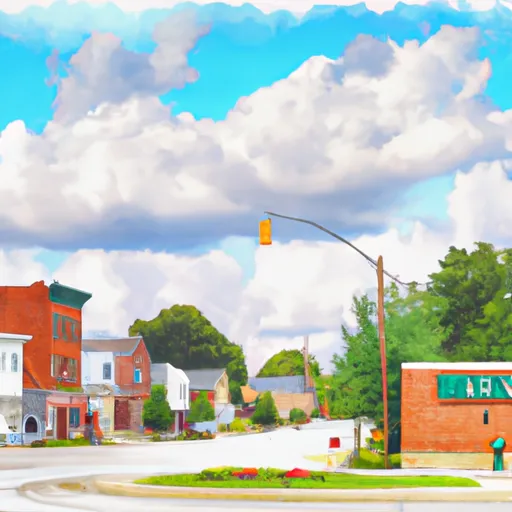-
 Snoflo Premium
Snoflo Premium
Get unlimited access to all our content
With no Ad interruptions! - Start Your Free Trial Login with existing account
Wyatt
Eden Index
Climate
7.6
•
Recreation
4.5
•
Community
•
Safeguard
4.6/10

Wyatt, Indiana is a small town in the Midwestern United States with a population of approximately 1,500 residents. The town experiences a humid continental climate, characterized by hot and humid summers, and cold, snowy winters. Average temperatures range from 20°F (-6°C) in the winter to 85°F (29°C) in the summer.
The hydrology of Wyatt is dominated by the nearby St. Joseph River, which runs along the town's eastern border. The river serves as a vital water source for the community, supporting recreational activities like fishing and boating. Additionally, several small lakes and ponds dot the landscape, providing further opportunities for water-based activities.
Outdoor recreation enthusiasts in Wyatt can take advantage of the town's rural surroundings. The region offers picturesque hiking trails, camping sites, and wildlife observation areas. In winter, residents can enjoy activities such as ice fishing, snowmobiling, and cross-country skiing.
Overall, Wyatt, Indiana provides a charming small-town atmosphere with a range of outdoor activities for residents and visitors to enjoy throughout the year.
What is the Eden Index?
The Snoflo Eden Index serves as a comprehensive rating system for regions, evaluating their desirability through a holistic assessment of climate health, outdoor recreation opportunities, and natural disaster risk, acknowledging the profound impact of these factors on livability and well-being.
Climate Health Indicator (CHI): 7.6
Wyatt receives approximately
1033mm of rain per year,
with humidity levels near 81%
and air temperatures averaging around
10°C.
Wyatt has a plant hardyness factor of
5, meaning
plants and agriculture in this region thrive during a short period during spring and early summer. Most
plants will die off during the colder winter months.
By considering the ideal temperature range, reliable water supplies, clean air, and stable seasonal rain or snowpacks, the Climate Health Indicator (CHI) underscores the significance of a healthy climate as the foundation for quality living.
A healthy climate is paramount for ensuring a high quality of life and livability in a region, fostering both physical well-being and environmental harmony. This can be characterized by ideal temperatures, reliable access to water supplies, clean air, and consistent seasonal rain or snowpacks.
Weather Forecast
Streamflow Conditions
Upper Illinois
Area Rivers
Upper Illinois
Snowpack Depths
Upper Illinois
Reservoir Storage Capacity
Upper Illinois
Groundwater Levels
Recreational Opportunity Index (ROI): 4.5
The Recreational Opportunity Index (ROI) recognizes the value of outdoor recreational options, such as parks, hiking trails, camping sites, and fishing spots, while acknowledging that climate plays a pivotal role in ensuring the comfort and consistency of these experiences.
Access to outdoor recreational opportunities, encompassing activities such as parks, hiking, camping, and fishing, is crucial for overall well-being, and the climate plays a pivotal role in enabling and enhancing these experiences, ensuring that individuals can engage in nature-based activities comfortably and consistently.
Camping Areas
| Campground | Campsites | Reservations | Toilets | Showers | Elevation |
|---|---|---|---|---|---|
| Buffalo Trace Co Park | 64 | 803 ft | |||
| Starve Hollow State Rec Area | 200 | 552 ft | |||
| Yellowwood State Forest | 80 | 613 ft | |||
| Irwin City Park | 12 | 662 ft | |||
| Mason Ridge - Morgan Monroe State Forest | 30 | 707 ft | |||
| Camp Atterbury Military | None | 715 ft | |||
| Heflen Co Park | None | 639 ft | |||
| Brown County State Park | 430 | 899 ft | |||
| Jackson - Washington State Forest | None | 672 ft | |||
| Delaney Creek Park | None | 584 ft |
Nearby Ski Areas
Catastrophe Safeguard Index (CSI):
The Catastrophe Safeguard Index (CSI) recognizes that natural disaster risk, encompassing floods, fires, hurricanes, and tornadoes, can drastically affect safety and the overall appeal of an area.
The level of natural disaster risk in a region significantly affects safety and the overall livability, with climate change amplifying these risks by potentially increasing the frequency and intensity of events like floods, fires, hurricanes, and tornadoes, thereby posing substantial challenges to community resilience and well-being.
Community Resilience Indicator (CRI):
The Community Resilience Indicator (CRI) recognizes that education, healthcare, and socioeconomics are crucial to the well-being of a region. The CRI acknowledges the profound impact of these elements on residents' overall quality of life. By evaluating educational resources, healthcare accessibility, and economic inclusivity, the index captures the essential aspects that contribute to a thriving community, fostering resident satisfaction, equity, and social cohesion.

